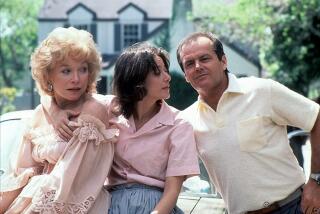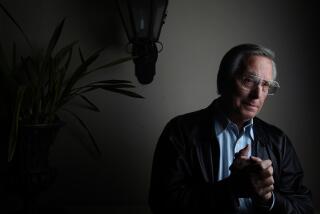‘Wild Bill’ was a tough taskmaster for tough times
- Share via
As profiles of him are required to note, William A. Wellman was known as “Wild Bill” to friend and foe alike. But what’s striking about the six Wellman-directed films in the third volume of Warner Bros.’ “Forbidden Hollywood” DVD series, released this week, is their often ruthless discipline.
However volatile Wellman was behind the camera -- he is reputed to have placed a truckload of manure atop a studio executive’s desk, along with a copy of a script he found unworthy of his talents -- his movies are models of economy, whizzing past plot points at breakneck speed, sometimes so fast that they come into focus only in the rearview mirror.
Wellman, who earned his nickname as a World War I aviator, brought a tough-minded sentimentality to such movies as “Wings” and “The Public Enemy.” He had an omnivorous appetite for Hollywood genres, trying his hand at melodrama and screwball comedy, problem pictures and Tarzan movies, with varying degrees of success.
Despite his antipathy to authority, Wellman was an energetic participant in the studio system, turning out as many as half a dozen films a year, a pace that reached its peak in the pre-code years.
Previous “Forbidden Hollywood” sets emphasized the sexually liberated women and morally compromised men who ran rampant on screen in the years before 1934, when the enforcement of the production code imposed a conservative social and political agenda on the industry’s output. But the half-dozen movies included here, all released between 1931 and 1933, aren’t a particularly salacious bunch.
There’s plenty of behavior that would have been unthinkable under the code, including unpunished adultery in “Other Men’s Women” and a mail-order marriage in “The Purchase Price,” but little in the way of superfluous sex and violence. (For that, you have to turn to Wellman’s “Night Nurse,” released in Volume Two.)
Wellman sometimes said he disliked working with actresses; in his brief on-screen career, his most notable accomplishment was cold-cocking Raoul Walsh’s wife. But he showed an affinity for the tough-talking broads of the pre-code era -- actresses like Loretta Young, whose career was strongly altered with the advent of the code, and Barbara Stanwyck, who survived by radically reconfiguring her screen persona.
The female crime lords of “Frisco Jenny” and “Midnight Mary,” played by Ruth Chatterton and Young, respectively, show a poise and power that make them the equal if not the superior of the men around them. They’re certainly more intriguing than Grant Withers’ blank-faced flirt in “Other Men’s Women,” whose trait is his habit of distributing gum at awkward moments.
“Wild Boys of the Road” doesn’t offer camp thrills or titillation, but its portrait of Depression-era life is sobering and at times astonishing. Following a pair of small-town teens who hop a boxcar looking for work, the movie sets their bright-eyed optimism on a collision course with the harsh reality of the times. As their numbers grow to dozens, then hundreds, the dispossessed younger generation forms its own society in a sewer-pipe shanty town, a place where justice is more likely to be administered by mob rule than by the police.
Emphasizing hard-bitten authenticity, including a sequence in which a limb is severed by a locomotive, Wellman mounts an implicit critique of the escapist spectacles of the time, casting Busby Berkeley dancer Dorothy Coonan (who would become the fourth Mrs. Wellman) as a cross-dressing tramp who winds up tap-dancing for her supper.
“Heroes for Sale” is even harsher. Richard Barthelmess returns from World War I a morphine addict, thanks to a stay in a German field hospital, and finds that a cowardly fellow soldier has taken credit for the raid in which he was wounded. Struggling to find his way back into society, he finds a job at an industrial laundry, only to be unfairly jailed when the workers’ attempt to improve their collective lot draws a violent response from the authorities.
When he emerges, the bread lines stretch for blocks, and the onetime war hero is left to trudge between towns, indomitable but still unfulfilled.
Both movies end on a guardedly upbeat note, paying obligatory tribute to the tenacity of the American spirit. But their studio-mandated optimism rings hollow next to the grim realism that precedes it, a trait the production code drove out along with salty dialogue and sultry come-ones.
--
More to Read
Only good movies
Get the Indie Focus newsletter, Mark Olsen's weekly guide to the world of cinema.
You may occasionally receive promotional content from the Los Angeles Times.







